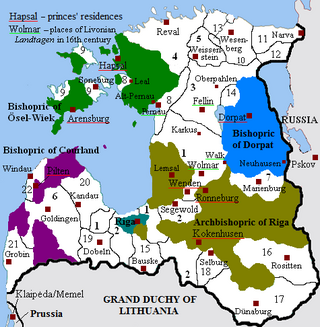
Livonia or in earlier records Livland, is a historical region on the eastern shores of the Baltic Sea. It is named after the Livonians, who lived on the shores of present-day Latvia.

The Livonian Order was an autonomous branch of the Teutonic Order, formed in 1237. From 1435 to 1561 it was a member of the Livonian Confederation.
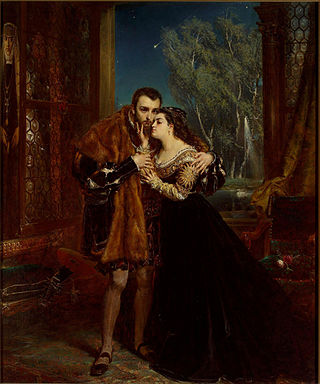
The Polish Golden Age was the Renaissance period in Poland and the Grand Duchy of Lithuania, roughly corresponding to the period of rule of the King Sigismund I the Old (1506–1548) and his son, Sigismund II Augustus, the last of the Jagiellonian Dynasty monarchs, until his death in 1572. Some historians argue that the Polish Golden Age continued into the mid-17th century, when the Polish–Lithuanian Commonwealth was ravaged by the Khmelnytsky Uprising (1648–57) and by the Swedish and Russian invasion. During its Golden Age, the Commonwealth became one of the largest kingdoms of Europe, stretching from modern Estonia in the north to Moldavia in the east and Bohemia in the west.

The Duchy of Courland and Semigallia was a duchy in the Baltic region, then known as Livonia, that existed from 1561 to 1569 as a nominally vassal state of the Grand Duchy of Lithuania and subsequently made part of the Crown of the Polish Kingdom from 1569 to 1726 and incorporated into the Polish–Lithuanian Commonwealth in 1726. On March 28, 1795, it was annexed by the Russian Empire in the Third Partition of Poland.
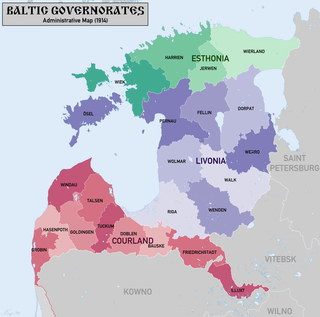
The Baltic governorates, originally the Ostsee governorates, was a collective name for the administrative units of the Russian Empire set up in the territories of Swedish Estonia, Swedish Livonia (1721) and, afterwards, of the Duchy of Courland and Semigallia (1795).

The Duchy of Livonia, also referred to as Polish Livonia or Livonia, was a territory of the Grand Duchy of Lithuania and later the Polish–Lithuanian Commonwealth that existed from 1561 to 1621. It corresponds to the present-day areas of northern Latvia and southern Estonia.

The Inflanty Voivodeship, or Livonian Voivodeship, also known as Polish Livonia, was an administrative division and local government in the Polish–Lithuanian Commonwealth, since it was formed in the 1620s out of the Wenden Voivodeship and lasted until the First Partition of Poland in 1772. The Inflanty Voivodeship was one of the few territories of the Polish–Lithuanian Commonwealth to be ruled jointly by Poland and Lithuania.

The Livonian War (1558–1583) was fought for control of Old Livonia. The Tsardom of Russia faced a varying coalition of the Dano-Norwegian Realm, the Kingdom of Sweden, and the Union of the Grand Duchy of Lithuania and the Kingdom of Poland.

Gotthard Kettler, Duke of Courland was the last Master of the Livonian Order and the first Duke of Courland and Semigallia.

Semigallia, also spelt Semigalia, is one of the Historical Latvian Lands located to the south of the Daugava river and to the north of the Saule region of Samogitia. The territory is split between Latvia and Lithuania, previously inhabited by the Semigallian Baltic tribe. They are noted for their long resistance (1219–1290) against the German crusaders and Teutonic Knights during the Northern Crusades. Semigallians had close linguistic and cultural ties with Samogitians.

Subdivisions of the Polish–Lithuanian Commonwealth evolved over for centuries of its existence from the signing of the Union of Lublin to the third partition.

Bauska Castle is a complex consisting of the ruins of an earlier castle and a later palace on the outskirts of the Latvian city of Bauska.
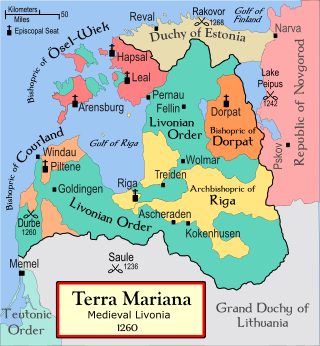
The Bishopric of Courland was the second smallest (4500 km2) ecclesiastical state in the Livonian Confederation founded in the aftermath of the Livonian Crusade. During the Livonian War in 1559 the bishopric became a possession of Denmark, and in 1585 sold by Denmark to Poland–Lithuania.

With the Capitulation of Estonia and Livonia in 1710 the Swedish dominions Estonia and Livonia were integrated into the Russian Empire following their conquest during the Great Northern War. The Livonian nobility and the city of Riga capitulated on 4 July (O.S.) / 15 July 1710 (N.S.), Pernau (Pärnu) in August, and the Estonian nobility and the city of Reval (Tallinn) on 29 September (O.S.) / 10 October (N.S.). Russia left the local institutions in place and confirmed the traditional privileges of the German nobles and burghers as was established in Privilegium Sigismundi Augusti, especially with respect to the Protestant faith. The land reform of the so-called reduction which had been introduced by the Swedish king Charles XI, and transformed many serfs to subjects of the Crown, was reversed.
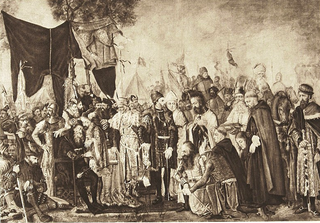
The Treaty or Peace of Pozvol, Pasvalys or Pozwol was a peace treaty and an alliance concluded on 5 and 14 September 1557 between the Livonian Confederation and the Polish-Lithuanian union, whereby the former put its territories under Polish-Lithuanian protection. The treaty was preceded by disputes between the members of the Livonian Confederation and military pressure by Sigismund II Augustus, King of Poland and Grand Duke of Lithuania, and provoked Russian tsar Ivan IV "the Terrible" to start the Livonian War.

The Treaty of Vilnius or Vilna was concluded on 28 November 1561, during the Livonian War, between the Livonian Confederation and the Grand Duchy of Lithuania in Vilnius. With the treaty, the non-Danish and non-Swedish part of Livonia, with the exception of the Free imperial city of Riga, subjected itself to the Grand Duke of Lithuania, Sigismund II Augustus with the Pacta subiectionis (Provisio ducalis). In turn, Sigismund granted protection from the Tsardom of Russia and confirmed the Livonian estates' traditional privileges, laid out in the Privilegium Sigismundi Augusti.

The Treaty of Vilnius or Vilna was a treaty signed at Vilnius on 31 August 1559 between the Livonian Order and the Grand Duchy of Lithuania. Gotthard von Kettler, the Master of the Livonian Order, put its lands under the protection of Sigismund II Augustus, the King of Poland and Grand Duke of Lithuania. While the alliance was intended to neutralize Russia's threat to annex the Order's lands and earned military support from Grand Lithuanian Chancellor Mikołaj "the Black" Radziwiłł, Kettler was ultimately unable to prevent Russian forces from occupying most of Livonia. Thus, Kettler signed a second treaty with Poland-Lithuania on 28 November 1561, transferring the remnants of the Teutonic Order State to the Polish Crown and the Grand Duchy of Lithuania, himself becoming a vassal of Sigismund II Augustus.
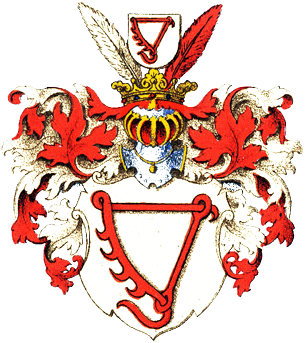
The House of Ketteler is the name of an old and distinguished Baltic German noble family that originated in Westphalia.

Terra Mariana was the official name for Medieval Livonia or Old Livonia. It was formed in the aftermath of the Livonian Crusade, and its territories were composed of present-day Estonia and Latvia. It was established on 2 February 1207, as a principality of the Holy Roman Empire, and lost this status in 1215 when Pope Innocent III proclaimed it as directly subject to the Holy See.

Landmeister in Livland was a high office in the Teutonic Order. The Landmeister administered the Livonia of the Teutonic Order. These lands had fallen to the Teutonic Order in 1237 by the incorporation of the former Livonian Brothers of the Sword. The seat of the Landmeister was castle Wenden. The Landmaster's function in Livonia lasted until 1561, when in aftermath of Livonian War the last Landmeister Gotthard Kettler relinquished the northern parts of the Mastery and in the Union of Vilna secularized the part still left to him and, as the Duchy of Courland and Semigallia, took fief from the Polish king and Grand Duke of Lithuania Sigismund II Augustus. The non-recognition of this act by Pope, Holy Roman Empire and the Grand Master of the Teutonic Order had no factual effect.


















